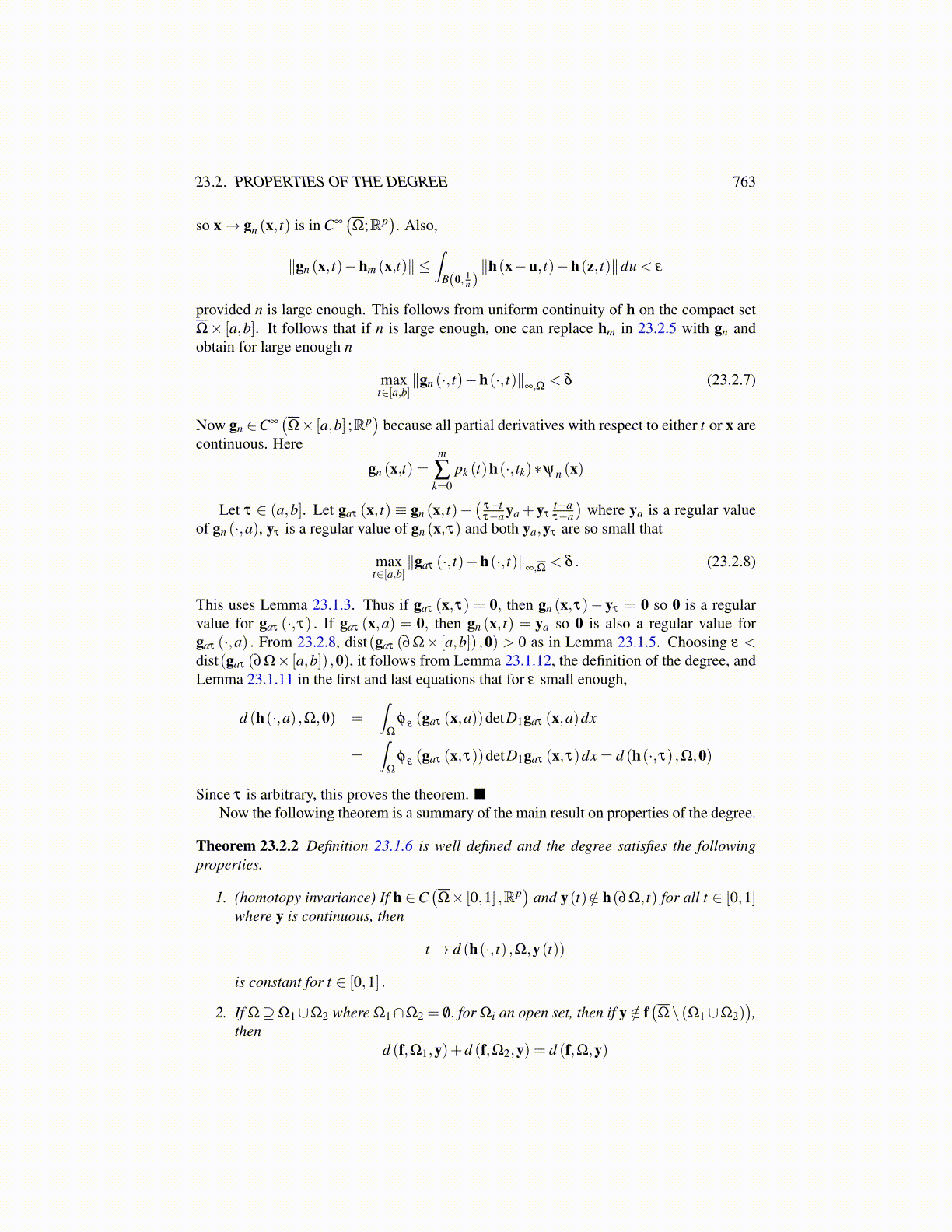
23.2. PROPERTIES OF THE DEGREE 763
so x→ gn (x, t) is in C∞(Ω;Rp
). Also,
∥gn (x, t)−hm (x,t)∥ ≤∫
B(0, 1n )∥h(x−u, t)−h(z, t)∥du < ε
provided n is large enough. This follows from uniform continuity of h on the compact setΩ× [a,b]. It follows that if n is large enough, one can replace hm in 23.2.5 with gn andobtain for large enough n
maxt∈[a,b]
∥gn (·, t)−h(·, t)∥∞,Ω < δ (23.2.7)
Now gn ∈C∞(Ω× [a,b] ;Rp
)because all partial derivatives with respect to either t or x are
continuous. Here
gn (x,t) =m
∑k=0
pk (t)h(·, tk)∗ψn (x)
Let τ ∈ (a,b]. Let gaτ (x, t) ≡ gn (x, t)−(
τ−tτ−a ya +yτ
t−aτ−a
)where ya is a regular value
of gn (·,a), yτ is a regular value of gn (x,τ) and both ya,yτ are so small that
maxt∈[a,b]
∥gaτ (·, t)−h(·, t)∥∞,Ω < δ . (23.2.8)
This uses Lemma 23.1.3. Thus if gaτ (x,τ) = 0, then gn (x,τ)− yτ = 0 so 0 is a regularvalue for gaτ (·,τ) . If gaτ (x,a) = 0, then gn (x, t) = ya so 0 is also a regular value forgaτ (·,a) . From 23.2.8, dist(gaτ (∂Ω× [a,b]) ,0) > 0 as in Lemma 23.1.5. Choosing ε <dist(gaτ (∂Ω× [a,b]) ,0), it follows from Lemma 23.1.12, the definition of the degree, andLemma 23.1.11 in the first and last equations that for ε small enough,
d (h(·,a) ,Ω,0) =∫
Ω
φ ε (gaτ (x,a))detD1gaτ (x,a)dx
=∫
Ω
φ ε (gaτ (x,τ))detD1gaτ (x,τ)dx = d (h(·,τ) ,Ω,0)
Since τ is arbitrary, this proves the theorem.Now the following theorem is a summary of the main result on properties of the degree.
Theorem 23.2.2 Definition 23.1.6 is well defined and the degree satisfies the followingproperties.
1. (homotopy invariance) If h ∈C(Ω× [0,1] ,Rp
)and y(t) /∈ h(∂Ω, t) for all t ∈ [0,1]
where y is continuous, then
t→ d (h(·, t) ,Ω,y(t))
is constant for t ∈ [0,1] .
2. If Ω⊇Ω1∪Ω2 where Ω1∩Ω2 = /0, for Ωi an open set, then if y /∈ f(Ω\ (Ω1∪Ω2)
),
thend (f,Ω1,y)+d (f,Ω2,y) = d (f,Ω,y)